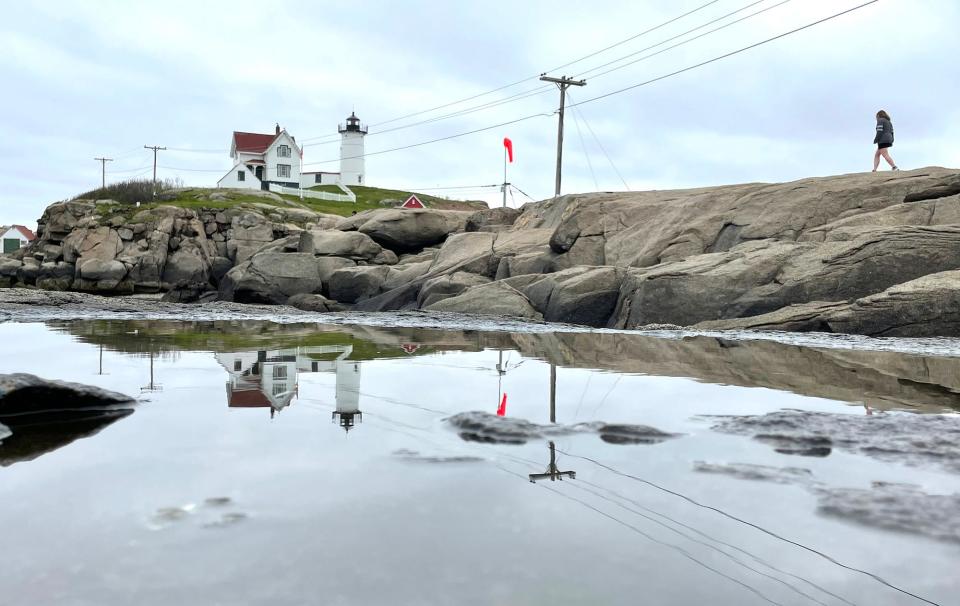York in American History: The men who built the Nubble and Boone Island Lighthouses
- Oops!Something went wrong.Please try again later.
Note: In this essay, James Kences enriches our understanding of the men who designed the two well-known lighthouses off the coast of York, the Nubble and Boone Island Lighthouses.
"Please detail a brigade at once to go to New Bridge to support Capt. Duane in throwing across his pontoon bridges..."
The officer who received these instructions on May 31, 1862, was William Buel Franklin, who only seven years earlier 1853-1854, as an administrator of the First Lighthouse District, designed the Boon Island Lighthouse. Capt. Duane, who was mentioned, was James Chatham Duane, destined 17 years later in 1879, to design the Cape Neddick Lighthouse, familiarly known as Nubble Light.

For a period of a few weeks during General McClellan's Peninsula Campaign of the spring of 1862 that was to witness Lee's assuming command of the Confederate army of Northern Virginia— in fact, only a day after the date of this dispatch— Franklin and Duane's names were frequently linked together. Thus, on the day of the battle at Gaine's Mill, June 27, McClellan telegraphed Franklin, "if you see a chance to go over the Duane bridge (across the Chickahominy) and take the enemy in flank, please do it." This occurred at the beginning of the famous "Seven Days" as Lee forced a rapid Union withdrawal from the vicinity of Richmond.
Though rarely given more than brief passing notice by the majority of authors of books on the lighthouses, both men, Franklin, and Duane, deserve to be acknowledged for their accomplishments. Franklin's structure on the rocky island situated six miles off the coast of York, has endured numerous storms over the course of more than a century and a half of severe weather, and is the tallest lighthouse in the region, at 133 feet. Duane's imprint upon Cape Neddick light, which is referred to as a cast iron "Duane tower," because it conformed to his unique design specifications, was equally strong.
The role these two men assumed during the Civil War, is also a part of their personal stories entirely absent from any of the books on the lighthouses. Franklin's rapid ascent in the ranks of the Union army from 1861 until 1862 was to culminate with his being chosen as one of the three "Grand Division" commanders at the Battle of Fredericksburg. Whether or not it was deserved, it was claimed he was to bear some responsibility for the major defeat that resulted in doubts of his performance as a major general.
York in American History:Thomas Nelson Page
Duane, in contrast, continued as an engineer throughout the course of the war, eventually being appointed chief engineer of the Army of the Potomac. In 1864, he helped to supervise one of the technical feats of the war, one of the longest pontoon bridges ever attempted in military history- 2200 feet in length. This bridge, assembled in a matter of hours in mid-June, enabled Grant to take his entire force across the James River, effectively eluding Lee, and the Confederate army in the opening phase of the final campaign of the war at Petersburg.
"I think it is pretty well to get across a great river and come up here and attack [Lee] in his rear before he is ready for us," Grant exulted over his daring strategy. "The great bridge was the scene of a continuous movement of infantry columns, batteries of artillery and wagon trains," observed Horace Porter. It was narrow, only 13 feet in width, and comprised of 101 individual pontoons. "I begin to see it. You will succeed – God bless you all," President Lincoln telegraphed Grant on June 15.

Ironically, it was only weeks later that Duane dismissed the idea of mining hundreds of feet underneath Confederate defenses for the placement of large quantities of gunpowder at Petersburg as "claptrap and nonsense" and so he would offer no support for the project that was to proceed in spite of his skeptical attitude. But he was proved wrong, and on July 30, 1864, a massive detonation occurred, that is known as "The Crater," the 30-foot-deep hole that resulted.
Franklin and Duane had attended West Point Military Academy and excelled as students, at the top of their classes. Franklin's first military experience was in the Mexican War. He was awarded for gallantry at Buena Vista. Duane became an instructor at West Point and was also Third District Lighthouse Engineer during the 1850s. This district embraced New York, Connecticut, and Rhode Island.
In October of 1852, the nine-member U.S. Lighthouse Board was formed shortly after an inspection was conducted of the status of existing lighthouses in the nation, which numbered over 330. Toward the end of that year, Franklin arrived in Portland, Maine, to oversee the First Lighthouse District. As revealed by Jane Porter's research in her book “Friendly Edifices,” over the course of Franklin's tenure, 22 lighthouses would be added to the total on the coast of northern New England.
York in American History: The York visits of Samuel Adams Drake
Franklin began to draft plans for a new lighthouse at Boon Island in December of 1852. This was to replace the structure that had stood since 1811, damaged by storms over the previous decades. Exactly two years later, work had approached completion, so the lantern and a second-order Fresnel lens were installed. The beehive-shaped 9-foot high lens, which bears the name of the French physicist who was its creator, was the transformative innovation for lighthouses, allowing the light to be seen at much greater distances than their predecessors. Boon Island was lit for the first time on January 1, 1855.
According to Porter, Franklin had prepared plans for a lighthouse at Cape Neddick, but it would not be until after the war ended, and Duane's entry into the First District, that the objective was finally realized. Duane was an advocate for a cast iron structure, based upon the argument it was "economical in cost, extremely durable, and cheap to maintain in repair." The parts intended for the new lighthouse were manufactured at a Portland foundry and transported by the Myrtle, one of the lighthouse tenders in the spring of 1879. The building was completed by mid-June.
A newspaper notice announced the inauguration of the lighthouse: "On or after July 1, 1879, a fixed red light, of the 4th order (a reference to the Fresnel lens design) ...will be shown from a conical iron tower, recently erected on York Nubble, Cape Neddick, Maine. The light should be seen at sea, 15 nautical miles..."
James Kences is the town historian for the town of York.
This article originally appeared on Portsmouth Herald: York in American History: The Nubble and Boone Island Lighthouses

